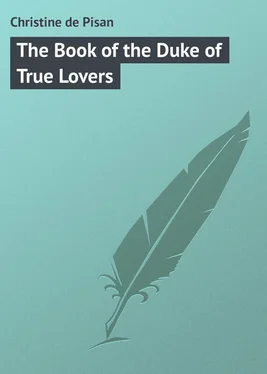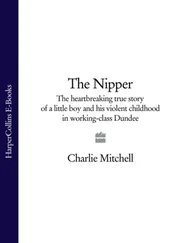Christine de Pisan - The Book of the Duke of True Lovers
Здесь есть возможность читать онлайн «Christine de Pisan - The Book of the Duke of True Lovers» — ознакомительный отрывок электронной книги совершенно бесплатно, а после прочтения отрывка купить полную версию. В некоторых случаях можно слушать аудио, скачать через торрент в формате fb2 и присутствует краткое содержание. Жанр: foreign_prose, Зарубежные любовные романы, на английском языке. Описание произведения, (предисловие) а так же отзывы посетителей доступны на портале библиотеки ЛибКат.
- Название:The Book of the Duke of True Lovers
- Автор:
- Жанр:
- Год:неизвестен
- ISBN:нет данных
- Рейтинг книги:5 / 5. Голосов: 1
-
Избранное:Добавить в избранное
- Отзывы:
-
Ваша оценка:
- 100
- 1
- 2
- 3
- 4
- 5
The Book of the Duke of True Lovers: краткое содержание, описание и аннотация
Предлагаем к чтению аннотацию, описание, краткое содержание или предисловие (зависит от того, что написал сам автор книги «The Book of the Duke of True Lovers»). Если вы не нашли необходимую информацию о книге — напишите в комментариях, мы постараемся отыскать её.
The Book of the Duke of True Lovers — читать онлайн ознакомительный отрывок
Ниже представлен текст книги, разбитый по страницам. Система сохранения места последней прочитанной страницы, позволяет с удобством читать онлайн бесплатно книгу «The Book of the Duke of True Lovers», без необходимости каждый раз заново искать на чём Вы остановились. Поставьте закладку, и сможете в любой момент перейти на страницу, на которой закончили чтение.
Интервал:
Закладка:
Christine de Pisan
The Book of the Duke of True Lovers
TRANSLATOR'S NOTE
The only two known MSS., both early fifteenth century French, of the love-story here rendered into English prose, are the one in the Bibliothèque Nationale (836), and that in the British Museum (Harley, 4431).
The MS. in the Bibliothèque Nationale forms one of the treasures of the famous collection of MSS. made by Jean, Duc de Berry, the Mecænas of illuminated MSS. At his death it passed into the possession of his daughter Marie, who, by marriage, had become Duchesse de Bourbon. When, in the reign of François I., the Connétable de Bourbon, to whom it had descended, was disgraced, the king seized his books and MSS., and carried them off to Fontainebleau, well pleased to add by any means, righteous or unrighteous, to the treasures of the royal library. Here this MS. and others remained until the reign of Charles IX., when they were removed to Paris, and placed in the Bibliothèque du Roi, now the world-famous Bibliothèque Nationale.
The MS. in the British Museum has also had an interesting and chequered career. It was originally presented by Christine de Pisan to Isabelle of Bavaria, the queen of Charles VI. of France, whose books and MSS. were, in 1425, acquired by John, Duke of Bedford, Regent of France. It is more than probable that this MS. was amongst these and was brought to England, for the various signatures on the enclosing parchment would certainly seem to indicate that this was the case. Late in the fifteenth century the MS. was sold to one of the most celebrated bibliophiles of the day, Louis of Bruges. After this, there is a blank in its history, until, in the seventeenth century, we find it once more in England, in the possession of Henry, Duke of Newcastle, whose grand-daughter married Edward Harley, Earl of Oxford, the founder of the splendid collection of MSS. and books purchased in 1754 for the British Museum, and now known as the Harleian Collection.
The writer of the story, Christine de Pisan, was one of the world's many famous women, and one who, by her life and work, created an ideal for womankind – that of sweetness and strength. Born in Venice in 1363, she was, when five years of age, taken by her mother to Paris, to join her father, Thomas de Pisan, who had been summoned thither by the king, Charles V., to serve as his astrologer, in which service he remained until the king's death. The Court of Charles V. was, in spite of the constant warfare that troubled his kingdom, at once most cultured and refined, and it was in such surroundings that Christine was brought up. At the age of fifteen she was married to the king's notary and secretary, Etienne de Castel, a gentleman of Picardy, who, however, died some ten years later, leaving her with three children to provide for. Like many another, she turned to letters as both a material and a mental support. She wrote not only purely lyrical poetry, of extraordinary variety and abundance considering that the subject is almost invariably the joys and sorrows of love, sometimes, as she tells us, expressing her own sentiments, sometimes those of others at whose request she wrote, but she also wrote sacred and scientific poems, and moral and political prose works, and a kind of romantic fiction, of which the story of The Duke of True Lovers is an example, although it is quite possible, and indeed probable, that it has some historic basis.
Christine begins her story by saying that it had been confided to her by a young prince who did not wish his name to be divulged, and who desired only to be known as The Duke of True Lovers. It has been suggested, with much likelihood, that this is the love story of Jean, Duc de Bourbon, and Marie, Duchesse de Berry, who has already been alluded to as the daughter of the famous Jean, Duc de Berry, and the inheritor of his MSS. This Marie had been married, when quite a child, to Louis III. de Chatillon, Comte de Dunois, and afterwards to Philippe d'Artois, Comte d'Eu, Constable of France, whose wife she was at the time when the incidents which have been woven into this story are supposed to have taken place. Philippe d'Artois only survived the marriage three or four years, and after three years of widowhood, the already much-married Marie wedded (1400) our hero, Jean, Duc de Bourbon.
The principal facts which seem to afford strong evidence in favour of connecting this love story with the two princely houses of Bourbon and Berry are (1) that the MS. originally formed part of the library of the Duc de Berry, and subsequently passed on marriage to that of the Duc de Bourbon; (2) that although Christine's MSS. generally were so copied and multiplied during her lifetime that they number even now at least two hundred, there is only one other copy – the one already referred to as being in the British Museum – known of this particular MS., this alone seeming to indicate that its contents were regarded as of a private family nature; and (3) that to add to the mystery, and to ensure secrecy, there is no definite ending to the romance. The story merely tells us that the ducal lover, harassed by mischief-makers, and unable to bear the pain of a separation in his own country which her position and his own gallantry alike demanded, departs with the army for an expedition in Spain. For ten years the lovers meet from time to time during the intervals between journeying and war, and further solace each other with short love-poems, expressive of pensive longing, and with these the story ends vaguely. But if we accept the story as being founded on real life, history supplies a more definite ending. As already stated, soon after the death of Marie's second husband, Philippe, the lovers are married, and spend a few happy years in their castle at Moulins, the chief town of the Duke's domains, surrounded by and enjoying rare works of art and literature, their happiness only marred by the unsettled state of France, and by consequent calls on the Duke to fight for his country. It was on one of such occasions – the memorable and decisive battle of Agincourt (1415) – that the Duke was made prisoner, and taken to London, where he died in captivity, and Marie, his Duchess, was left to mourn, and this time in real sorrow.
Thus ends the story, which Christine has told with her wonderful gift as painter-poet. Besides making the lovers, and that noxious growth of civilisation, the inevitable scandal-monger, intensely living through her womanly sympathy and psychological insight, and introducing, in the form of a letter, a most comprehensive and remarkable treatise on feminine morality, the dangers of illicit love, and the satisfaction of simple wifely duty, she takes us in imagination to a royal castle of the fifteenth century. There we seem to live the daily life of its courtly circle, and, through the vivid description of the sumptuous pageant, to take part in the three days' tournament, and in the merry revels which bring each day to a close. As we read, we realise the extraordinary power of this woman, who seems in description to use the exact and detailed brush of a Meissonier, whilst in her outlook on life she possesses the broader and freer touch of a Puvis de Chavannes. Truly is it a master-mind indeed which can see life largely, and see it well!
Much might be written about the interesting and talented Christine, but we must bid her farewell now and here. Still she must ever be held in remembrance for her untiring championship of two things very near to her heart – a patriotic love for the land of her adoption, and an ardent devotion to the cause of womankind. She had the happiness before her death, which occurred about 1430 in the Convent of Poissy, near Paris, to which she had retired, of seeing France aroused to patriotism, and that, too, by a woman – Joan of Arc.
THE BOOK OF THE DUKE OF TRUE LOVERS
Интервал:
Закладка:
Похожие книги на «The Book of the Duke of True Lovers»
Представляем Вашему вниманию похожие книги на «The Book of the Duke of True Lovers» списком для выбора. Мы отобрали схожую по названию и смыслу литературу в надежде предоставить читателям больше вариантов отыскать новые, интересные, ещё непрочитанные произведения.
Обсуждение, отзывы о книге «The Book of the Duke of True Lovers» и просто собственные мнения читателей. Оставьте ваши комментарии, напишите, что Вы думаете о произведении, его смысле или главных героях. Укажите что конкретно понравилось, а что нет, и почему Вы так считаете.











